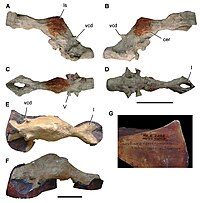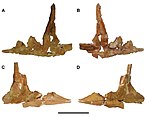鯊齒龍屬
| 鯊齒龍屬 | |
|---|---|

| |
| 鯊齒龍頭骨,展示於明尼蘇達科博館 | |
| 科學分類 | |
| 界: | 動物界 Animalia |
| 門: | 脊索動物門 Chordata |
| 綱: | 蜥形綱 Sauropsida |
| 總目: | 恐龍總目 Dinosauria |
| 目: | 蜥臀目 Saurischia |
| 亞目: | 獸腳亞目 Theropoda |
| 科: | †鯊齒龍科 Carcharodontosauridae |
| 亞科: | †鯊齒龍亞科 Carcharodontosaurinae |
| 屬: | †鯊齒龍屬 Carcharodontosaurus Stromer, 1931 |
| 模式種 | |
| †撒哈拉鯊齒龍 Carcharodontosaurus saharicus (Depéret & Savornin, 1925)
| |
| 種 | |
| 異名 | |
| |
鯊齒龍(屬名:Carcharodontosaurus,發音:/ˌkɑːrkəroʊˌdɒntoʊˈsɔːrəs/,或譯望齒龍、卡查齒龍、噬人鯊龍)是種巨型肉食性恐龍,屬於獸腳亞目鯊齒龍科,生存於白堊紀晚期之初(森諾曼階,約1億到9300萬年前)的北非,相當於現代的埃及、阿爾及利亞、摩洛哥、尼日等地。
屬名意為「鯊魚牙齒的蜥蜴」,取自鯊魚(Carcharodon)為名;其中karcharos/κάρχαρος意為「鋸齒狀的」,odōn/ὀδών意為「牙齒」。[1]首批化石於20世紀初發現於北非,保存於德國但在二戰期間被炸毀。直到20世紀末才又發現新的化石。屬下目前包含兩個已命名物種:模式種撒哈拉鯊齒龍(C. saharicus)、伊吉迪鯊齒龍(C. iguidensis)。鯊齒龍身長約12公尺,與棘龍、暴龍、南方巨獸龍並列為目前已知最大型的肉食性恐龍之一,體型相當甚至可能超越後者。
發現與研究歷史
[編輯]1924年,在阿爾及利亞的陸間組發現兩顆牙齒,呈現出當時前所未見的獨特特徵。這些牙齒由Depéret和Savornin(1925)命名為新種撒哈拉斑龍(Megalosaurus saharicus),[2]後來被歸類為傷龍的亞屬。[3]幾年後,古生物學家斯特莫描述了來自埃及森諾曼階巴哈利亞組的一具部分頭骨和骨骼(Stromer,1931);於1914年發現,包括部分頭骨、牙齒、脊椎、爪子、骨盆、腿骨。這項新發現中的牙齒與Depéret和Savornin當初描述的特徵相符,因此保留種名saharicus,並有必要建立成新屬-鯊齒龍,意指其牙齒與鯊魚非常相似。[1]

史卓墨描述的骨骼於1944年二戰期間被炸毀。直到將近半個世紀後的1995年,由保羅·塞里諾所帶領的挖掘團隊在摩洛哥卡瑪卡瑪群發現了一具較完整的頭骨,發現位置靠近阿爾及利亞邊境,且接近Depéret和Savornin(1925)描述的最初牙齒的發現地;頭骨其餘部分亦與Depéret和Savornin(1925)、Stromer(1931)相符。這個新頭骨於2007年由史蒂芬·布賽特和塞里諾定為鯊齒龍的新模標本,同時敘述了來自尼日艾奇卡組的新種伊吉迪鯊齒龍,其與撒哈拉種在上頜骨和腦殼方面有所差異。[4]
Chiarenza和Cau(2016)討論了鯊齒龍的分類定義,並指出撒哈拉鯊齒龍的新模標本與正模標本相似但略有不同,且產生了質疑,因為比起新模標本,撒哈拉鯊齒龍正模標本與伊吉迪鯊齒龍正模標本更為相似。作者亦指出,伊吉迪鯊齒龍的其他參考材料屬於斯基瑪薩龍和一種非鯊齒龍科,於是將伊吉迪種的定義限制於正模標本,並有待未來進一步研究。[5]
敘述
[編輯]體型
[編輯]
鯊齒龍屬包含了一些已知最大型且最重的肉食性恐龍物種,許多科學家估計撒哈拉鯊齒龍身長介於12至13.3公尺,體重介於6.2至15.1公噸。[6][7][8][9]2016年Molina-Pérez和Larramendi給出撒哈拉鯊齒龍新模標本身長12.8公尺及體重7.8公噸、歸入伊吉迪鯊齒龍的牙齒標本身長11公尺及體重5.2公噸的估計值。[10]
鯊齒龍是肉食性動物,擁有龐大、側扁的頜部,以及長扁、邊緣鋸齒狀、長至8吋的牙齒。撒哈拉鯊齒龍的新模標本頭骨重建長度為1.42至1.6公尺。[11][7]葛瑞格利·保羅估計伊吉迪鯊齒龍身長10公尺及重4公噸。[12]
腦部與內耳
[編輯]2001年,拉森(Hans C. E. Larsson)發表了撒哈拉鯊齒龍的內耳和顱內描述。從最接近吻尖的腦部是前腦;再由中腦接續,以45度角朝後下;最後是後腦,大致與前腦平行,與中腦成45度角。整體上撒哈拉鯊齒龍的腦部與近緣的脆弱異特龍相似。拉森還發現鯊齒龍的大腦與全腦質量比率呈現非鳥類爬蟲類的典型狀況。鯊齒龍還擁有巨大的視神經。[13]
撒哈拉鯊齒龍內耳的三條半規管側視呈亞三角形輪廓,此形狀的內耳也同時出現在異特龍、蜥蜴、烏龜,但鳥類沒有。半規管本身非常線性,解釋了輪廓的銳度。生前小腦鬈指向半規管環繞區域,如同其他非鳥類獸腳類、鳥類、翼龍類。[13]
古生物學
[編輯]食性
[編輯]皇家蒂勒爾博物館恐龍館長韓德森(Donald Henderson)的一份研究指出,根據頜部、頸部及重心力量,鯊齒龍能用頜部舉起最重達424公斤的獵物。[14]
埋藏學
[編輯]SGM-Din 1標本(鯊齒龍頭骨)鼻骨有圓形穿刺傷口、框前緣異常突出。[15]
分類
[編輯]以下演化樹取自Apesteguía等人(2016),呈現鯊齒龍在鯊齒龍科的演化位置:[16]
| ||||||||||||||||||||||||||||||||||||||||||||||||||||||||||
參考來源
[編輯]- ^ 1.0 1.1 Stromer, E. (1931). "Wirbeltiere-Reste der Baharijestufe (unterestes Canoman). Ein Skelett-Rest von Carcharodontosaurus nov. gen." Abhandlungen der Bayerischen Akademie der Wissenschaften, Mathematisch-naturwissenschaftliche Abteilung, 9(Neue Folge): 1–23.
- ^ Deparet, C.; Savornin, J. Sur la decouverte d'une faune de vertebres albiens a Timimoun (Sahara occidental). Comptes Rendus de l'Académie des Sciences de Paris. 1925, 181: 1108–1111.
- ^ Deparet, C.; Savornin, J. La faune de reptiles et de poisons albiens de Timimoun (Sahara algérien). Bulletin de la Société Géologique de France. 1927, 27: 257–265.
- ^ Brusatte, S.L. and Sereno, P.C. (2007). "A new species of Carcharodontosaurus (dinosauria: theropoda) from the Cenomanian of Niger and a revision of the genus." Journal of Vertebrate Paleontology, 27(4): .
- ^ Chiarenza, Alfio Alessandro; Cau, Andrea. A large abelisaurid (Dinosauria, Theropoda) from Morocco and comments on the Cenomanian theropods from North Africa. PeerJ. February 29, 2016, 4: e1754. ISSN 2167-8359. PMC 4782726
 . PMID 26966675. doi:10.7717/peerj.1754.
. PMID 26966675. doi:10.7717/peerj.1754.
- ^ Holtz, Thomas R. Jr. (2012) Dinosaurs: The Most Complete, Up-to-Date Encyclopedia for Dinosaur Lovers of All Ages, Winter 2011 Appendix. (頁面存檔備份,存於互聯網檔案館)
- ^ 7.0 7.1 Sereno, P. C.; Dutheil, D. B.; Iarochene, M.; Larsson, H. C. E.; Lyon, G. H.; Magwene, P. M.; Sidor, C. A.; Varricchio, D. J.; Wilson, J. A. Predatory Dinosaurs from the Sahara and Late Cretaceous Faunal Differentiation. Science. 1996, 272 (5264): 986–991. Bibcode:1996Sci...272..986S. PMID 8662584. S2CID 39658297. doi:10.1126/science.272.5264.986.
- ^ Seebacher, F. A New Method to Calculate Allometric Length-Mass Relationships of Dinosaurs (PDF). Journal of Vertebrate Paleontology. 2001, 21 (1): 51–60 [2021-07-04]. ISSN 0272-4634. doi:10.1671/0272-4634(2001)021[0051:ANMTCA]2.0.CO;2. (原始內容存檔 (PDF)於2016-03-04).
- ^ Therrien, F.; Henderson, D.M. My theropod is bigger than yours...or not: estimating body size from skull length in theropods. Journal of Vertebrate Paleontology. 2007, 27 (1): 108–115. ISSN 0272-4634. doi:10.1671/0272-4634(2007)27[108:MTIBTY]2.0.CO;2.
- ^ Molina-Pérez & Larramendi. Récords y curiosidades de los dinosaurios Terópodos y otros dinosauromorfos, Larousse. Barcelona, Spain. 2016: 262.
- ^ Carrano, Matthew T.; Benson, Roger B. J.; Sampson, Scott D. The phylogeny of Tetanurae (Dinosauria: Theropoda). Journal of Systematic Palaeontology. 2012, 10 (2): 211–300. ISSN 1477-2019. S2CID 85354215. doi:10.1080/14772019.2011.630927 (英語).
- ^ Paul, G.S., 2010, The Princeton Field Guide to Dinosaurs, Princeton University Press.
- ^ 13.0 13.1 Larsson, H.C.E. 2001. Endocranial anatomy of Carcharodontosaurus saharicus (Theropoda: Allosauroidea) and its implications for theropod brain evolution. pp. 19–33. In: Mesozoic Vertebrate Life. Ed.s Tanke, D. H., Carpenter, K., Skrepnick, M. W. Indiana University Press.
- ^ The Science Behind This Violent Dino Eiffel Tower is Revolutionary. [2021-07-04]. (原始內容存檔於2016-12-17).
- ^ "Acrocanthosauridae fam. nov.," in Molnar (2001). Pg. 342.
- ^ Sebastián Apesteguía; Nathan D. Smith; Rubén Juárez Valieri; Peter J. Makovicky. An Unusual New Theropod with a Didactyl Manus from the Upper Cretaceous of Patagonia, Argentina. PLOS ONE. 2016, 11 (7): e0157793. Bibcode:2016PLoSO..1157793A. PMC 4943716
 . PMID 27410683. doi:10.1371/journal.pone.0157793.
. PMID 27410683. doi:10.1371/journal.pone.0157793.

























